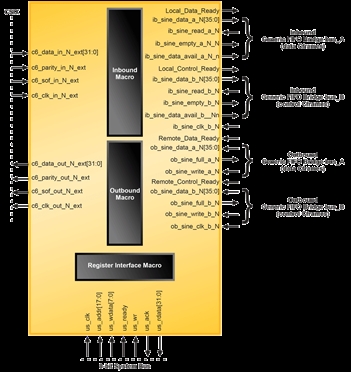You are here:

CSIX Level 1
As stated by the CSIX Forum, the CSIX standard defines the physical and message layers of the interconnect between traffic managers (TM) and the switching fabric. The CSIX interface is designed to support a wide variety of system architectures and markets; and provides a framework with a common set of mechanisms for enabling a fabric and a TM to communicate. This includes unicast addressing for up to 4096 fabric ports, and multiple traffic classes that isolate data going to the same fabric port. Link level flow control is in-band and broken into a data and a control queue to isolate traffic based on this granular type. Flow control between the fabric and TM is defined and is relative to both fabric port and class. Three multicast approaches are defined. The interface assumes cell segmentation in the TM, but allows compression of the transfer.
Lattice Semiconductor’s CSIX Level 1 IP core links a compliant CSIX-L1 interface to Lattice’s Generic FIFO Bridge interface (a simple FIFO interface). Inbound control and data frames from the CSIX port are deposited into the core's inbound FIFOs; CSIX frames stored in the core’s outbound FIFOs are driven onto the outbound CSIX interface. The Generic FIFO Bridge interface directly accesses the core's inbound and outbound FIFOs.
Lattice Semiconductor’s CSIX Level 1 IP core links a compliant CSIX-L1 interface to Lattice’s Generic FIFO Bridge interface (a simple FIFO interface). Inbound control and data frames from the CSIX port are deposited into the core's inbound FIFOs; CSIX frames stored in the core’s outbound FIFOs are driven onto the outbound CSIX interface. The Generic FIFO Bridge interface directly accesses the core's inbound and outbound FIFOs.
查看 CSIX Level 1 详细介绍:
- 查看 CSIX Level 1 完整数据手册
- 联系 CSIX Level 1 供应商
Block Diagram of the CSIX Level 1

FPGA IP
- RT-630-FPGA Hardware Root of Trust Security Processor for Cloud/AI/ML SoC FIPS-140
- Complete USB Type-C Power Delivery PHY, RTL, and Software
- Ethernet TSN Switch IP Core - Efficient and Massively Customizable
- CXL 2.0 Agilex FPGA Acclerator Card
- PCIe Gen3 to SRIO Gen3 Bridge (FPGA)
- 65nm/40nm Low Power eFPGA IP and Open Source FPGA Software






